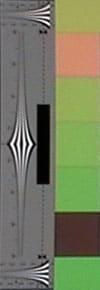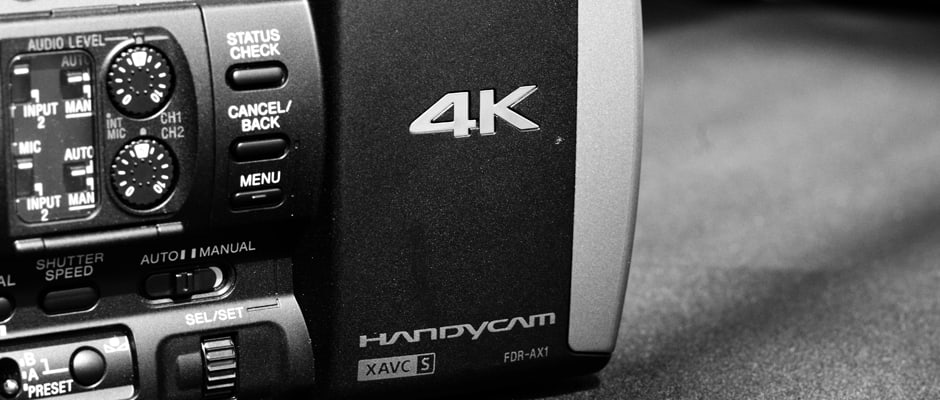Our First Take
Even though this isn't exactly the kind of camera suited for weekend soccer games or your vacation in Cancun, it's a necessary first step towards the new higher-definition world Sony's envisioned for all of us. With a brand-new codec, dual (proprietary) memory card slots, and a pro-style body, the 4K Handycam certainly isn't going to be confused with a Flip anytime soon.
But with a new faster form of memory on the market, 4K displays invading homes, and editing tools catching up with the format, it seems as though 4K has finally arrived. Is the FDR-AX1 the model that will push it over the edge?
Design & Usability
Big, with a button for everything.
Covered from lens to battery in switches and buttons, the "Handycam" label on the FDR-AX1 may seem out of place. It well might be, though Sony does have to make the distinction between something like the AX1 (and it's 1080/30p predecessor, the FDR-AX2000) and serious professional workhorse cameras like Sony's F65. Either way, the AX1 clearly means business, and its suite of manual controls and advanced settings will require a studied hand to get the most out of the camera.
{{photo_gallery "tour"}}
If you're not using the 4K Handycam on a tripod or stabilized mount, the easiest way to shoot with it is with the handstrap on the right side. We found it to be a pinch on the heavy side when holding it with one hand. Within reach of the strap is a large, variable zoom rocker and a record button for your thumb, surrounded by a power switch.
The handle on the top of the 4K Handycam has record and zoom controls built into it. Fiip open the tiny LCD and you'll find an array of other controls for the menu system. Along the left hand side of the camcorder are the rest of the controls. There's a slider for the built-in ND filter, audio controls (underneath a clear hard plastic cover, so they don't get jostled accidentally), custom buttons, a focus toggle, white balance controls and more.

Ports are lined up neatly on the back of the camcorder. Inexplicably, the 4K Handycam comes with component out, with only one HDMI. There's a headphone jack, XLR mic jacks, and a couple of options for flash storage. Since 4K needs plenty of bandwidth, the FDR-AX1 sports two XQD card slots as well as a typical SD card slot. But, beware, the SD card slot can only record 1080p video, not 4K. The investment in XQD cards is certainly something to consider, but Sony is bundling a 32GB card with the AX1 and prices have come down somewhat since the format debuted with Nikon's flagship professional DSLR, the D4.
One thing to note for more advanced users is the lack of HD-SDI output on the FDR-AX1, which will be a bummer if you only use an SDI monitor and wanted to give 4K a try. It's unfortunate, but Sony has also announced a more pro-centric 4K model, the PXW-Z100. The Z100 records "true 4K" with the full XAVC codec (not XAVC S, which we'll get into in a moment) and offers 3G-SDI output for people still using HD workflows. While it's not quite as cheap as the FDR-AX1, the Z100 still comes in at a retail price under $6,500 and should be out later this year.
Features
Enough for pros, too much for consumers?
Even though Sony makes mention of the consumer-level price on the 4K Handycam, it's not going to take off with that crowd. Here's a tip to figure out whether or not a camcorder is for consumers: is there a "zebra" button on the side? If so, you're holding a prosumer or pro camera. Which is exactly what this is.
Sony's only selling the FDR-AX1 as a package to start off. Your 4.5 grand nets you the camera, the 32GB XQD memory card, and Vegas Pro. It's nice to see that this is an all-in-one solution for filmmakers starting from scratch, or those who want to jump into 4K with both feet.
The 4K Handycam utilizes a 20x optical zoom lens, with a maximum aperture of f/1.6-3.4. The camera also has a 3-level ND filter built-in, making this a great camera for all kinds of lighting conditions. The camera's software can suggest a level of ND intensity if desired, or you can control it manually.
When shooting at its max resolution, the 4K Handycam encodes using XAVC S, a format which uses existing MP4/H.264 compression along with Linear PCM audio compression. It's a fairly efficient codec, enabling a rate of around 1 hour of 4K footage for every 32GBs of XQD flash storage. For comparison's sake, we've been told that a 64GB card using Sony's full XAVC 4K codec will only manage around 15 minutes of footage at 60p. Of course, XAVC nets you full 4-2-2 chroma subsampling, while XAVC S is limited to 4-2-0.

One interesting detail has to do with the 4K Handycam's HDMI implementation. Since this camera was developed by Sony before the HDMI 2.0 standard was ratified, it can only output 4K/60p footage to Sony's Bravia 4K televisions. But, fear not, Sony has plans to issue a firmware update to the 4K Handycam down the road so it can play nicely with all the new HDMI 2.0 4K devices soon to hit the market.
Conclusion
We're keeping an eye on this one.
The 4K Handycam almost can't be called a Handycam. Not only does it offer all the bells and whistles of a high-end camcorder, it also uses an expensive, up-and-coming storage standard and a brand new recording format. This isn't a video camera for people who like to play it safe, but it might just appeal to videographers who like to take a walk on the cutting-edge side. Proprietary memory, a pared down version of a brand new codec, and promises of future firmware upgrades to mesh with third-party products that aren't on the market yet. Welcome to early adoption.

We also can't help but think that after truly disruptive cameras like the Blackmagic's Cinema Camera or their promised Production Camera, Sony's traditional approach might fall on deaf ears. The idea of having to wait for yet another new memory format to continue dropping in price rings like something from 2003.
We're looking forward to putting this camcorder through its paces properly when it arrives in our labs, but for now, we're curious what types of videographers will gravitate towards the 4K Handycam's package. 4K is still in its infancy, but Sony is certainly hoping this relatively affordable camera will be the toe in the water for many shooters when it debuts later this year.
Meet the tester
Brendan is originally from California. Prior to writing for Reviewed.com, he graduated from UC Santa Cruz and did IT support and wrote for a technology blog in the mythical Silicon Valley. Brendan enjoys history, Marx Brothers films, Vietnamese food, cars, and laughing loudly.
Checking our work.
Our team is here for one purpose: to help you buy the best stuff and love what you own. Our writers, editors, and lab technicians obsess over the products we cover to make sure you're confident and satisfied. Have a different opinion about something we recommend? Email us and we'll compare notes.
Shoot us an email

